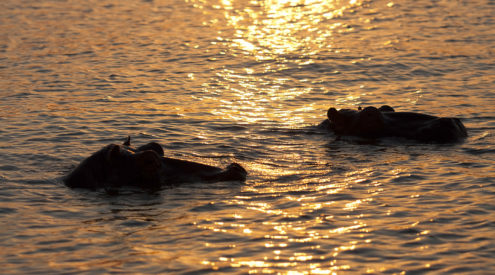The Bangweulu Wetlands in northern Zambia is the only place in Africa where the black lechwe antelope still occur in significant numbers. After the first rains the flood plains look like a massive green lawn – the biggest lawn imaginable! It was on this lawn that we sat and peeled the last orange in our panniers while absorbing the vastness of the wetland plains. Black lechwes could be seen in almost any direction. Before sunrise, in the early morning, the plains are covered in a thick blanket of fog. Using this fog as cover we tried to get closer to the lechwes for a good picture. We could hear them grazing long before we spotted them. With the break of day, the shapes of thousands of lechwe stood silhoetted in the golden haze.
In the afternoons clouds built up dramatically in the skies. Standing on the endless plains with your eyes closed, you can almost hear the vastness around you. Sunset is a spectacular display of light and clouds.
Bangweulu is also home to the incredibly beautiful shoebill – a large stork-like bird. Their appearance is strangely prehistoric and almost hypnotic. When you see a shoebill, you cannot help but stare at them: they are comic, loveable, and awe-inspiring at the same time. David Ngwenyama is doing research on the shoebill population in the Bangweulu Wetlands. He monitors the nests on a weekly basis. Of the two eggs usually laid, only the stronger chick survives. Many chicks are stolen from the nests and sold on the black market to zoos and collectors, but there are now active conservation interventions that will save many of these birds.
Local fishermen are not discouraged from utilising the healthy fish population in the swamps although fishing is controlled by traditionally appointed members of the community. After the rains and subsequent flooding of the area, fish populations explode. Fishing is the main livelihood for the locals.
The dung of the 75 000 Black lechwe no doubt fertilize the flood plains, making excellent feeding grounds for the fish. Carl Huchzermeyer is doing his Master’s degree on the fish population. We joined Carl on his regular morning walk to buy fish for his studies at the local fishing camp. We saw several kinds of fish in the day’s catch.
Carl pointed out that the bulldog fish have very big brains and are able to produce electric currents in their tails. They use these electric signals to communicate and to find food. They can decipher different electric messages, hence the need for the big brain.
We were amazed by the large flocks of water birds constantly rising out of the swamps as we walked along. We ticked off a few lifers, including spurwing lapwing, blue-breasted bee-eater, Katanga masked weaver, Denham’s bustard and the coppery-tailed coucal. We also saw pink-throated long-claw, lappet-faced vulture, osprey, and black-breasted snake eagle.
We also paid a visit to Kerri Rademeyer at the Bangweulu Wetlands headquarters, where we stayed in a luxurious canvas tent with a beautiful view. These canvas tents are available to self-drive tourists. We joined Kerry and Simon for dinner that night and ate like kings. The next morning we woke to the sound of an African broadbill nearby.
Bangweulu Wetlands is a community park managed by African Parks, a non-government organization (NGO), that takes on total responsibility for the rehabilitation and long-term management of national parks, in public-private partnership with African governments. Kerri believes that better land-use planning should be the new way of conservation in community parks. Park managers must think and plan long term, since every action has far-reaching consequences.
Bangweulu Wetlands is a remote park that doesn’t draw an awful amount of tourists each year. Additional activities are being explored to raise enough money to make the park sustainable. Hunting will be encouraged in future since the the black lechwe population has no more large natural predators.
An example of Bangweulu Wetland’s community conservation strategies include exploring a new millet strain that doesn’t require slash-and-burn farming practices. Normally, local people chop down patches of trees and burn it to fertilise the soil. The traditional type of millet used now can only grow in the soil for one season; after which, the soil is depleted of its nutrients. Consequently, a new patch will be cleared the following season. This slash-and-burn approach is very destructive to the environment. In other parts of Zambia, conservation farming methods like planting the nitrogen-binding winter thorn (ana tree) in between their crops has been a huge success.
While we stayed at the research station at Chikuni, Carl and David made sure we were well-fed on local fish and other dishes, something we really needed as we had arrived half-starved. Some dishes were even cooked in a solar cooker! During these rest-days we learnt an incredible amount about this fascinating ecosystem. We fell in love with the expanse of teeming nature surrounding us. Sadly, after a stay of three unforgettable days we had to move on. We consoled ourselves that we would return to this unexplored paradise one day.
Bangweulu Wetlands
Visit the Bangweulu Wetlands website for more information.
Email [email protected]
















